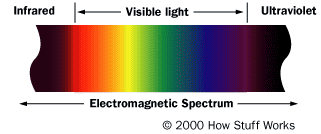The Incredible Infrared Science Behind Night Vision Displays
The way night vision works depends on the technology used. First, there is Image Enhancement, which works by collecting the tiny amounts of light present and amplifying it to point where it can be easily observed. This includes the entire infrared light spectrum. Next, there is Thermal Imaging, which works by capturing the upper portion of the infrared light spectrum emitted as heat by objects. Hotter objects emit more light than cooler objects.
What is infrared light? Infrared light can be split into three categories. Near-infrared, Mid-infrared and Far-infrared (thermal-infrared). The difference between these has to do with the amount of energy in their wavelengths. For example, shorter wavelengths have higher amounts of energy. Near-IR has the shortest wavelength, less than 1.5 microns, and is closest to what humans can see as visible light. Far-IR can be up to 30 microns and is emitted from an object, rather than reflected. The Infrared spectrum display shows that violet contains the most energy whereas red has the least amount.
Night-vision applications are commonly used in the military, law enforcement, hunting, surveillance, security, navigations and hidden-object detection. Night-vision technology is usually seen in 3 types of equipment:
1. Scopes: a one eye-piece either handheld or mounted on a weapon. These are good for getting an enhanced look at an object and quickly being able to return to normal viewing conditions.
2. Goggles: Most often worn on the head, but can be handheld. They are binocular with either a single or stereo lens. Goggles are ideal for constant viewing, such as traveling through a dark building.
3. Cameras: Send an image to a monitor for display or to a VCR for recording. They are often used in a permanent location, like mounted on the dashboards of automobiles. Night-vision cameras are becoming a feature in luxury cars to increase a vehicle driver’s perception and seeing distance at night or in poor weather conditions.
Instrument Systems instruments are used for carrying out measurements on night vision compatible displays (NVIS) and panel graphics. The DTS 140D NVIS Spectroradiometer addresses that it is critical that the extremely high intensity differences between the visible and near infrared spectral ranges are measured correctly (380 to 780 nm and 650 to 930 nm, respectively – the latter being the sensitivity range of the NVG Night Vision Goggle). Specific modifications to the CAS 140 series include further suppression of stray light and automatic adjustment of measurement sensitivity to cope with the differing signal intensities. The DTS 140D NVIS is ideal for manufacturing and quality control applications that require long-term dependability and simple operation.












